PORSCHE PANAMERA 2009 1.G Information Manual
Manufacturer: PORSCHE, Model Year: 2009, Model line: PANAMERA, Model: PORSCHE PANAMERA 2009 1.GPages: 343, PDF Size: 7.96 MB
Page 211 of 343
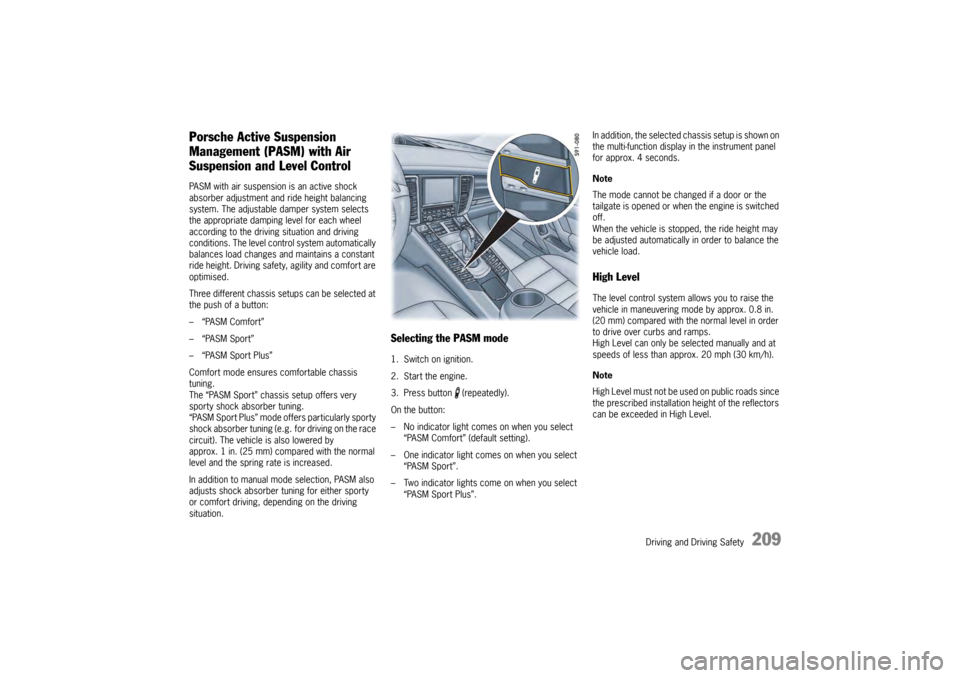
Driving and Driving Safety
209
Porsche Active Suspension
Management (PASM) with Air
Suspension and Level ControlPASM with air suspension is an active shock
absorber adjustment and ride height balancing
system. The adjustable damper system selects
the appropriate damping level for each wheel
according to the driving situation and driving
conditions. The level control system automatically
balances load changes and maintains a constant
ride height. Driving safety , agility and comfort are
optimised.
Three different chassis setups can be selected at
the push of a button:
– “PASM Comfort”
– “PASM Sport”
– “PASM Sport Plus”
Comfort mode ensures comfortable chassis
tuning.
The “PASM Sport” chassis setup offers very
sporty shock absorber tuning.
“PASM Sport Plus” mode offers particularly sporty
shock absorber tuning (e.g. for driving on the race
circuit). The vehicle is also lowered by
approx. 1 in. (25 mm) compared with the normal
level and the spring rate is increased.
In addition to manual mode selection, PASM also
adjusts shock absorber tuning for either sporty
or comfort driving, depending on the driving
situation.
Selecting the PASM mode1. Switch on ignition.
2. Start the engine.
3. Press button (repeatedly).
On the button:
– No indicator light come s on when you select
“PASM Comfort” (default setting).
– One indicator light comes on when you select “PASM Sport”.
– Two indicator lights come on when you select
“PASM Sport Plus”. In addition, the selected chassis setup is shown on
the multi-function display in the instrument panel
for approx. 4 seconds.
Note
The mode cannot be changed if a door or the
tailgate is opened or when the engine is switched
off.
When the vehicle is stopped, the ride height may
be adjusted automatically
in order to balance the
vehicle load.
High LevelThe level control system al lows you to raise the
vehicle in maneuvering mode by approx. 0.8 in.
(20 mm) compared with the normal level in order
to drive over curbs and ramps.
High Level can only be selected manually and at
speeds of less than approx. 20 mph (30 km/h).
Note
High Level must not be us ed on public roads since
the prescribed installation height of the reflectors
can be exceeded in High Level.
Page 212 of 343
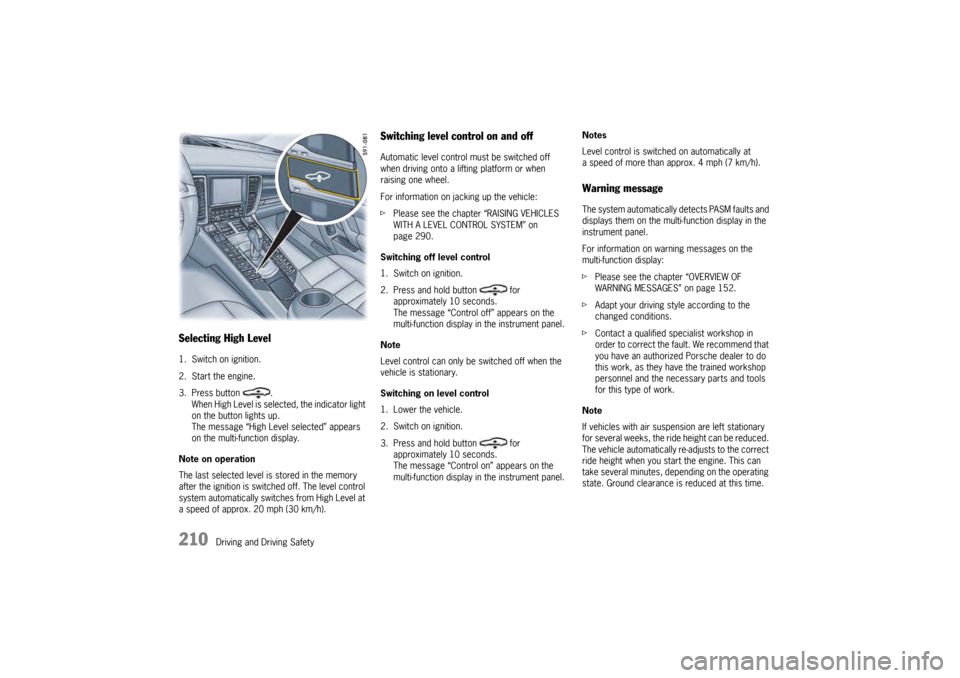
210
Driving and Driving Safety
Selecting High Level1. Switch on ignition.
2. Start the engine.
3. Press button .When High Level is selected, the indicator light
on the button lights up.
The message “High Level selected” appears
on the multi-function display.
Note on operation
The last selected level is stored in the memory
after the ignition is switched off. The level control
system automatically switches from High Level at
a speed of approx. 20 mph (30 km/h).
Switching level control on and offAutomatic level control must be switched off
when driving onto a lifting platform or when
raising one wheel.
For information on ja cking up the vehicle:
f Please see the chapter “RAISING VEHICLES
WITH A LEVEL CONTROL SYSTEM” on
page 290.
Switching off level control
1. Switch on ignition.
2. Press and hold button for approximately 10 seconds.
The message “Control off” appears on the
multi-function display in the instrument panel.
Note
Level control can only be switched off when the
vehicle is stationary.
Switching on level control
1. Lower the vehicle.
2. Switch on ignition.
3. Press and hold button for approximately 10 seconds.
The message “Control on” appears on the
multi-function display in the instrument panel. Notes
Level control is switched on automatically at
a speed of more than approx. 4 mph (7 km/h).
Warning messageThe system automatically
detects PASM faults and
displays them on the multi-function display in the
instrument panel.
For information on warning messages on the
multi-function display:
f Please see the chapter “OVERVIEW OF
WARNING MESSAGES” on page 152.
f Adapt your driving style according to the
changed conditions.
f Contact a qualified specialist workshop in
order to correct the fault. We recommend that
you have an authorized Porsche dealer to do
this work, as they have the trained workshop
personnel and the necessary parts and tools
for this type of work.
Note
If vehicles with air suspension are left stationary
for several weeks, the ride height can be reduced.
The vehicle automatically re-adjusts to the correct
ride height when you start the engine. This can
take several minutes, depending on the operating
state. Ground clearance is reduced at this time.
Page 213 of 343

Driving and Driving Safety
211
Porsche Dynamic Chassis Control
(PDCC) FunctionThe Porsche Dynamic Chassis Control (PDCC)
system used on vehicles with air suspension is
a system for roll stabilisation of the vehicle body
when driving.
Driving comfort and driving safety are improved
by active intervention of the anti-roll bars on the
front and rear axles. Ve hicle balance and agility
are optimised.
No separate controls are available for the PDCC
system.
When you select a chassis setup in Porsche Active
Suspension Management (PASM) with air
suspension and level control, the PDCC system
automatically activates the corresponding on-road
driving program.
For information on selecting a chassis setup:
f Please see the chapter “PORSCHE ACTIVE
SUSPENSION MANAGEMENT (PASM) WITH AIR
SUSPENSION AND LEVEL CONTROL” on
page 209.
Warning messageThe warning message “Fault PDCC” or “PDCC
failure” appears on the mult i-function display in the
instrument panel if there is a system fault.
For information on warning messages on the
multi-function display:
f Please see the chapter “OVERVIEW OF
WARNING MESSAGES” on page 152.
f Adapt your driving style according to the
changed conditions.
f Contact a qualified specialist workshop in
order to correct the fa ult. We recommend that
you have an authorized Porsche dealer to do
this work, as they have the trained workshop
personnel and the necessary parts and tools
for this type of work.
Checking hydraulic fluidThe hydraulic fluid is checked and changed
regularly as part of servicing.
For information on maintenance:
f Please see the chapter “EXERCISE EXTREME
CAUTION WHEN WORKING ON YOUR VEHICLE”
on page 252.
Page 214 of 343

212
Driving and Driving Safety
“Sport” and “Sport Plus” Mode FunctionThe selectable chassis settings mean that the
vehicle can offer various modes for a sportier
overall setup.
When “Sport” or “Sport Plus” mode is selected, all
the vehicle’s control systems are intentionally
shifted towards greater agility and driving
performance:
– PASM (Porsche Active Suspension Management) is automa tically changed to
“PASM Sport” or “PASM Sport Plus” mode,
resulting in a stiffer suspension setup.
The vehicle switches to Low Level in “PASM
Sport Plus” mode.
f Please see the chapter “PORSCHE ACTIVE
SUSPENSION MANAGEMENT (PASM)” on
page 208.
– Just like PASM, PDCC is switched to the corresponding “Sport” or “Sport Plus” mode,
whereby the rolling movements of the vehicle
are reduced further, depending on the
selected mode.
f Please see the chapter “PORSCHE DYNAMIC
CHASSIS CONTROL (PDCC)” on page 211.
– The PDK transmission switches to a sporty gear-changing map and shortens the gear
shifting times when Sport mode is activated.
Gear changes take place faster. f
Please see the chapter ““SPORT” AND “SPORT
PLUS” MODE” on page 195.
– The electronic accelerator pedal reacts sooner, and the engine is more responsive to
throttle inputs. When Sport mode is switched
on and the vehicle is travelling at a speed of
less than 25 mph (40 km/h), this function is
activated only after the driver has floored the
accelerator pedal or released it briefly.
– The rpm limiter characteristic is “harder”. In other words: the engine is immediately
throttled when the performance limits are
reached (only in manual selection mode on
vehicles with PDK).
– The turbo overboost briefly increases the engine boost pressure in the engine speed
range from 2,500 rpm to approx. 4,000 rpm.
As a result, torque in this speed range is
increased by 70 Nm (52 ftlb.). This
considerably improves acceleration and
flexibility, particularly in the medium engine
speed range. This does not affect the
maximum power. Quickly flooring the
accelerator pedal acti vates turbo overboost
in the engine control system. Overboost has
an effective operating time of approx.
10 seconds. After this time, it can be re-
activated by quickly flooring the accelerator
pedal again. – PSM (Porsche Stability Management) control is
more sporty in “Sport Plus” mode. PSM
interventions are later than in Normal mode.
The driver can maneuver the vehicle with
greater agility at it s performance limits,
without having to dispense with the assistance
of PSM in emergency situations. This helps to
achieve optimal lap times, particularly on race
circuits with a dry road surface.
f Please see the chapter “PORSCHE STABILITY
MANAGEMENT (PSM)” on page 202.
– Adaptive cruise control regulates speed and distance more dynamically.
– The Auto Start Stop function is deactivated.
f Please see the chapter “AUTO START STOP
FUNCTION” on page 169.
– The rear spoiler extends earlier and retracts later (“Sport Plus” mode only).
f Please see the chapter “RETRACTABLE REAR
SPOILER” on page 214.
– The system switches from High Level.
f Please see the chapter “HIGH LEVEL” on
page 209.
Page 215 of 343
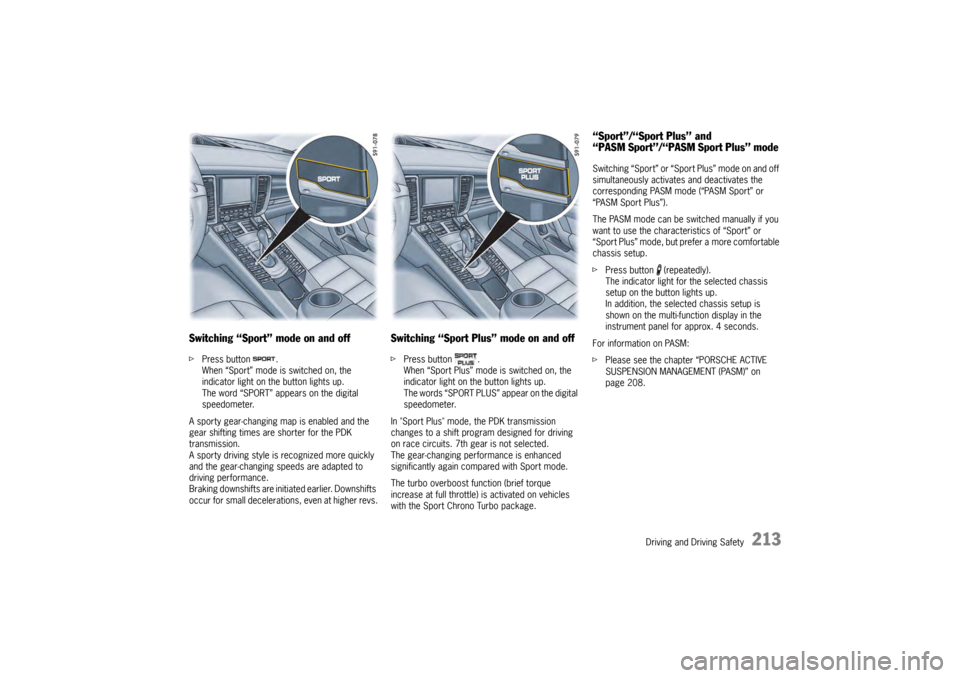
Driving and Driving Safety
213
Switching “Sport” mode on and offfPress button .
When “Sport” mode is switched on, the
indicator light on the button lights up.
The word “SPORT” appears on the digital
speedometer.
A sporty gear-changing map is enabled and the
gear shifting times ar e shorter for the PDK
transmission.
A sporty driving style is recognized more quickly
and the gear-changing speeds are adapted to
driving performance.
Braking downshifts are initiated earlier. Downshifts
occur for small decelerations, even at higher revs.
Switching “Sport Plus” mode on and offf Press button .
When “Sport Plus” mode is switched on, the
indicator light on the button lights up.
The words “SPORT PLUS” appear on the digital
speedometer.
In "Sport Plus" mode, the PDK transmission
changes to a shift progra m designed for driving
on race circuits. 7th gear is not selected.
The gear-changing performance is enhanced
significantly again compared with Sport mode.
The turbo overboost function (brief torque
increase at full throttle) is activated on vehicles
with the Sport Chrono Turbo package.
“Sport”/“Sport Plus” and
“PASM Sport”/“PASM Sport Plus” mode Switching “Sport” or “Sport Plus” mode on and off
simultaneously activates and deactivates the
corresponding PASM mode (“PASM Sport” or
“PASM Sport Plus”).
The PASM mode can be sw itched manually if you
want to use the characteristics of “Sport” or
“Sport Plus” mode, but prefer a more comfortable
chassis setup.
f Press button (repeatedly).
The indicator light for the selected chassis
setup on the button lights up.
In addition, the selected chassis setup is
shown on the multi-function display in the
instrument panel for approx. 4 seconds.
For information on PASM:
f Please see the chapter “PORSCHE ACTIVE
SUSPENSION MANAGEMENT (PASM)” on
page 208.
Page 216 of 343
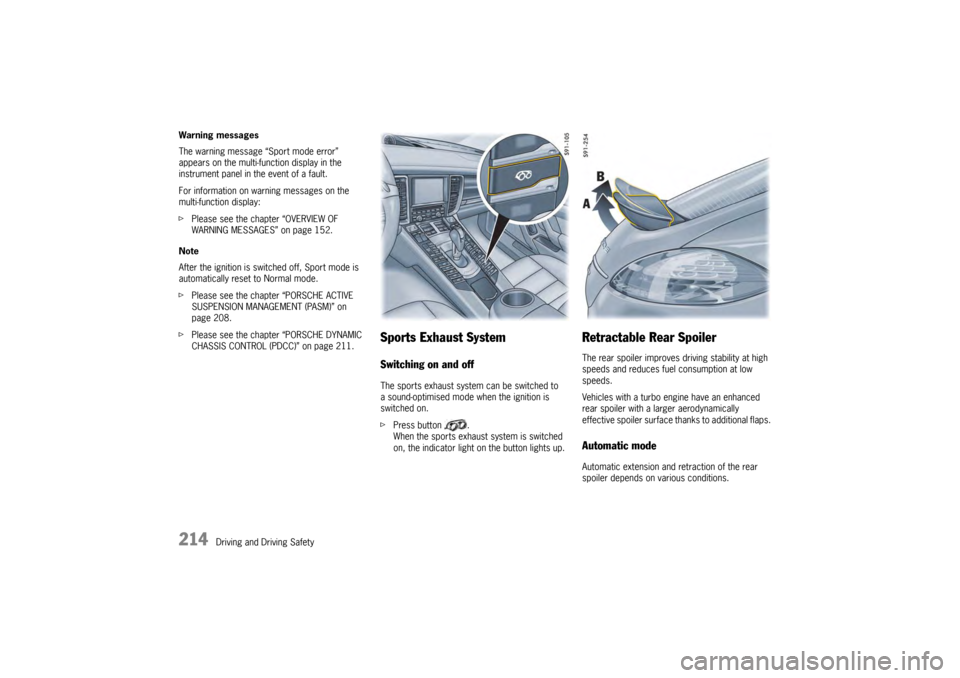
214
Driving and Driving Safety
Warning messages
The warning message “Sport mode error”
appears on the multi-f
unction display in the
instrument panel in the event of a fault.
For information on warning messages on the
multi-function display:
f Please see the chapter “OVERVIEW OF
WARNING MESSAGES” on page 152.
Note
After the ignition is switched off, Sport mode is
automatically reset to Normal mode.
f Please see the chapter “PORSCHE ACTIVE
SUSPENSION MANAGEMENT (PASM)” on
page 208.
f Please see the chapter “PORSCHE DYNAMIC
CHASSIS CONTROL (PDCC)” on page 211.
Sports Exhaust SystemSwitching on and offThe sports exhaust system can be switched to
a sound-optimised mode when the ignition is
switched on.
fPress button .
When the sports exhaust system is switched
on, the indicator light on the button lights up.
Retractable Rear SpoilerThe rear spoiler improves driving stability at high
speeds and reduces fuel consumption at low
speeds.
Vehicles with a turbo engine have an enhanced
rear spoiler with a larger aerodynamically
effective spoiler surface thanks to additional flaps.Automatic modeAutomatic extension and retraction of the rear
spoiler depends on various conditions.
Page 217 of 343
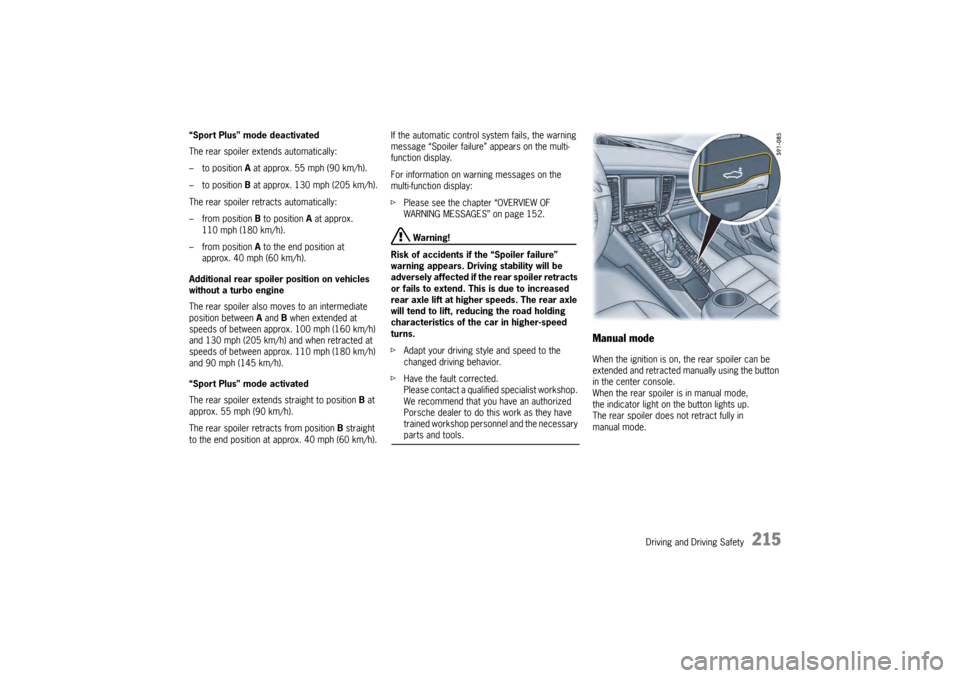
Driving and Driving Safety
215
“Sport Plus” mode deactivated
The rear spoiler extends automatically:
– to position A at approx. 55 mph (90 km/h).
– to position B at approx. 130 mph (205 km/h).
The rear spoiler retracts automatically:
–from position B to position A at approx.
110 mph (180 km/h).
–from position A to the end position at
approx. 40 mph (60 km/h).
Additional rear spoiler position on vehicles
without a turbo engine
The rear spoiler also mo ves to an intermediate
position between A and B when extended at
speeds of between appr ox. 100 mph (160 km/h)
and 130 mph (205 km/h) and when retracted at
speeds of between appr ox. 110 mph (180 km/h)
and 90 mph (145 km/h).
“Sport Plus” mode activated
The rear spoiler extends straight to position B at
approx. 55 mph (90 km/h).
The rear spoiler retracts from position B straight
to the end position at approx. 40 mph (60 km/h). If the automatic control system fails, the warning
message “Spoiler failure”
appears on the multi-
function display.
For information on warning messages on the
multi-function display:
f Please see the chapter “OVERVIEW OF
WARNING MESSAGES” on page 152.
Warning!
Risk of accidents if the “Spoiler failure”
warning appears. Driving stability will be
adversely affected if th e rear spoiler retracts
or fails to extend. This is due to increased
rear axle lift at higher speeds. The rear axle
will tend to lift, reducing the road holding
characteristics of the car in higher-speed
turns.
f Adapt your driving style and speed to the
changed driving behavior.
f Have the fault corrected.
Please contact a qualified specialist workshop.
We recommend that you have an authorized
Porsche dealer to do this work as they have
trained workshop personnel and the necessary parts and tools.
Manual modeWhen the ignition is on, the rear spoiler can be
extended and retracted manually using the button
in the center console.
When the rear spoiler is in manual mode,
the indicator light on the button lights up.
The rear spoiler does not retract fully in
manual mode.
Page 218 of 343

216
Driving and Driving Safety
Extending the rear spoiler manually
f
Press button briefly.
The rear spoiler extends to position A .
The indicator light on the button lights up.
The rear spoiler is in manual mode.
Retracting a manually extended rear spoiler
f when the vehicle is stationary
Press and hold button until the rear
spoiler has reached its end position.
The indicator light on the button goes out.
The rear spoiler is in automatic mode.
f at speeds of up to approx. 55 mph
(90 km/h)
Press button .
The rear spoiler retracts and the indicator light
on the button goes out.
The rear spoiler is in automatic mode.
f at speeds of more than approx. 55 mph
(90 km/h)
Press button .
The rear spoiler remains extended and the
indicator light on the button goes out.
The rear spoiler is in automatic mode. “Sport Plus” mode deactivated
The rear spoiler extends automatically from
position A
to position B at approx. 130 mph
(205 km/h).
The rear spoiler retracts automatically from
position B to position A at approx. 110 mph
(180 km/h).
“Sport Plus” mode activated
The rear spoiler extends automatically from
position A to position B at approx. 55 mph
(90 km/h).
The rear spoiler retracts automatically from
position B to position A at approx. 40 mph
(60 km/h).
Warning!
Risk of injury during manual retraction or
extension of the rear sp oiler when the vehicle
is stationary.
f Make sure that no pe rsons or objects are
within the range of movement of the rear
spoiler.
Risk of damage from pushing the vehicle by
the spoiler.
f Do not push the vehicl e at the rear spoiler.
Page 219 of 343
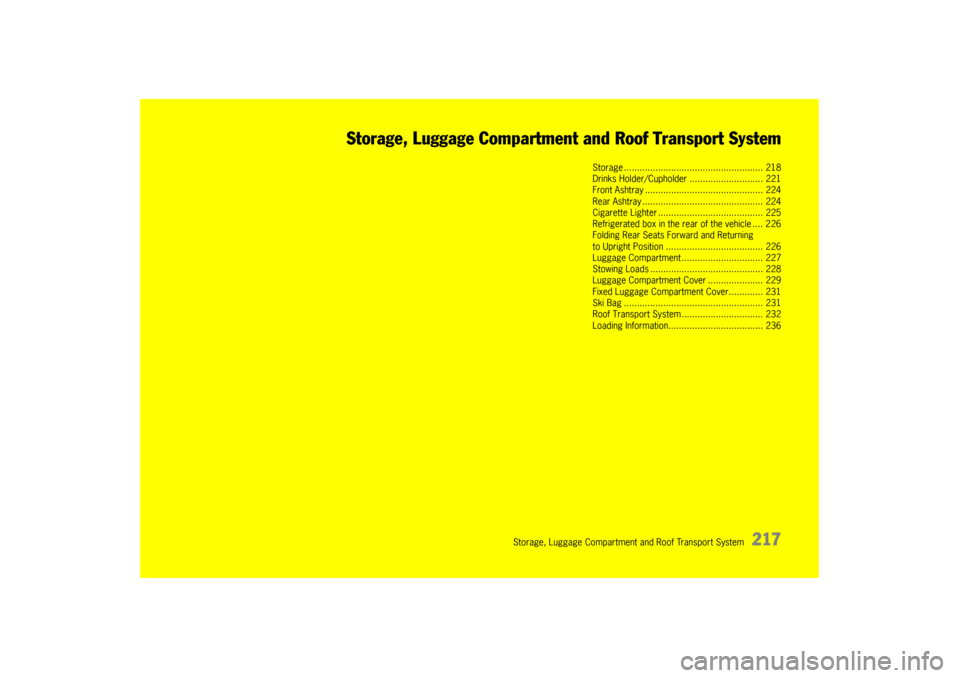
Storage, Luggage Compartment and Roof Transport System
217
Storage, Luggage Compartment and Roof Transport System
Storage ...........................................
.......... 218
Drinks Holder/Cuphold er ............................ 221
Front Ashtray ............... .............................. 224
Rear Ashtray ................ .............................. 224
Cigarette Lighter ..... ................................... 225
Refrigerated box in the re ar of the vehicle .... 226
Folding Rear Seats Forward and Returning
to Upright Position .. ................................... 226
Luggage Compartment . .............................. 227
Stowing Loads ............. .............................. 228
Luggage Compartment Cover ..................... 229
Fixed Luggage Compartm ent Cover............. 231
Ski Bag ....................... .............................. 231
Roof Transport System ............................... 232
Loading Information. ................................... 236
Page 220 of 343
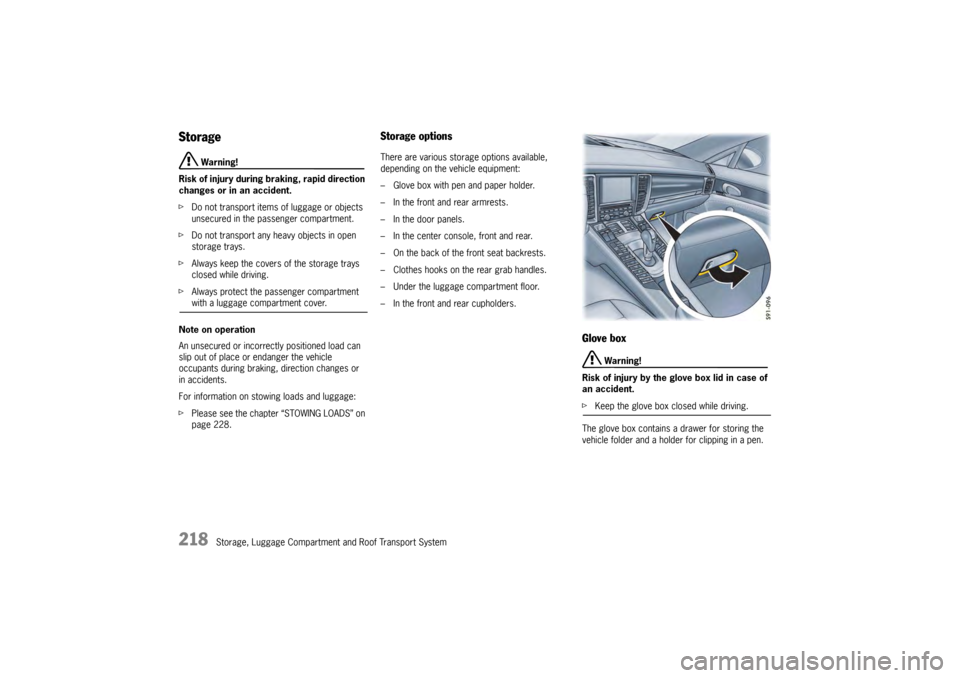
218
Storage, Luggage Compartment and Roof Transport System
Storage
Warning!
Risk of injury during braking, rapid direction
changes or in an accident.
f Do not transport items of luggage or objects
unsecured in the passenger compartment.
f Do not transport any heavy objects in open
storage trays.
f Always keep the covers of the storage trays
closed while driving.
f Always protect the passenger compartment with a luggage compartment cover.
Note on operation
An unsecured or incorrectly positioned load can
slip out of place or endanger the vehicle
occupants during braking, direction changes or
in accidents.
For information on stowing loads and luggage:
f Please see the chapter “STOWING LOADS” on
page 228.
Storage optionsThere are various storage options available,
depending on the vehicle equipment:
– Glove box with pen and paper holder.
– In the front and rear armrests.
– In the door panels.
– In the center console, front and rear.
– On the back of the front seat backrests.
– Clothes hooks on the rear grab handles.
– Under the luggage compartment floor.
– In the front and rear cupholders.
Glove box
Warning!
Risk of injury by the glove box lid in case of
an accident.
f Keep the glove box closed while driving.
The glove box contains a drawer for storing the
vehicle folder and a holder for clipping in a pen.